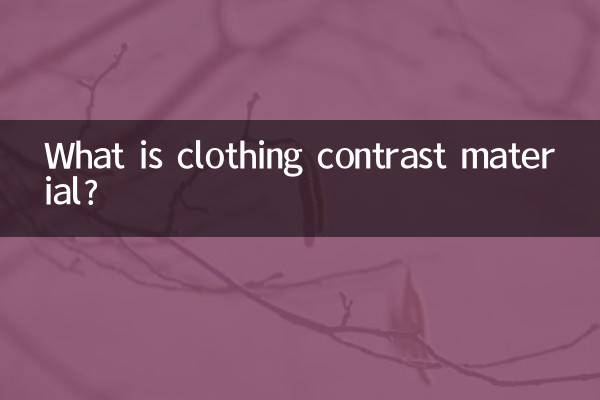What is clothing contrast material?
In the past 10 days, one of the hot topics in the clothing industry has been "clothing collision materials". This phenomenon has triggered widespread discussions on social media and e-commerce platforms, and has even become a new focus for consumers when shopping. So, what exactly is "clothing bumping"? How does it impact consumers and brands? This article will give you a detailed explanation based on the hot content of the entire network in the past 10 days.
1. What is clothing collision material?

"Clothing collision" refers to the use of the same or similar fabrics, patterns or design elements in clothing of different brands or styles, resulting in consumers finding multiple pieces of clothing "colliding" or "colliding styles" when purchasing. This phenomenon is particularly common among fast fashion brands, but it is also gradually spreading to the high-end market.
2. Common types of clothing collision materials
| Type | Description | Example |
|---|---|---|
| Fabric bumping | Different brands use the same fabric material or texture | Several brands simultaneously launched dresses made of "acetate fiber" |
| Pattern bumping material | Similar or identical design elements such as printing and embroidery | The popular "daisy" pattern in the summer of 2023 has been adopted by many brands |
| Style and contrasting materials | Clothing styles and cuts are highly similar | Several brands launch tops with "square neck puff sleeves" design |
3. Analysis of the causes of clothing collision
According to industry discussions in the past 10 days, the main reasons for clothing collision include:
| Reason | Proportion | Description |
|---|---|---|
| Trend driven | 45% | Brands chase the same popular elements |
| Fabric supply chain concentration | 30% | Multiple brands source fabrics from the same supplier |
| Design plagiarism | 15% | Fast fashion brands imitate high-end designs |
| other reasons | 10% | Including production cost considerations, etc. |
4. Consumers’ attitudes towards clothing materials
According to social media data analysis, consumers’ attitudes towards clothing materials are polarized:
Supporters’ point of view:
1. Reduce the cost of acquiring popular items
2. Provides more price options
3. Helps form a unified fashion style
Opponent’s point of view:
1. Diminishes the uniqueness of clothing
2. Reduced brand recognition
3. May lead to uneven quality
5. How brands deal with the phenomenon of clothing collision
1.Strengthen original design:Invest more resources in developing unique designs
2.Customized exclusive fabrics:Cooperate with fabric manufacturers to develop exclusive materials
3.Highlight brand features:Strengthen brand recognition through detailed design
4.Transparent supply chain:Explain fabric sources and design processes to consumers
6. Forecast of future trends
According to analysis by industry experts, the phenomenon of clothing collision may show the following trends in the future:
| Trend | possibility | influence |
|---|---|---|
| The rise of personalization | high | Consumers seek unique designs |
| Sustainable fabrics are valued | Middle to high | Environmentally friendly materials have become a differentiated selling point |
| Digital clothing development | in | Virtual fashion reduces physical collisions |
Conclusion
The phenomenon of clothing collision reflects the current trend of homogeneity in the clothing industry, and it also prompts brands to think about how to achieve differentiation through innovation. For consumers, this presents both a challenge and an opportunity – the need to make smarter choices about clothing that truly suits them. In the future, as consumer awareness increases and technology advances, we expect to see more creative solutions.

check the details

check the details